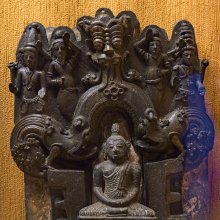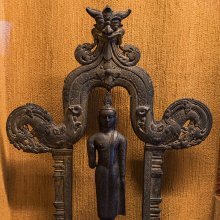Makaratorana, Makaratoraṇa, Makara-torana: 3 definitions
Introduction:
Makaratorana means something in Hinduism, Sanskrit, the history of ancient India. If you want to know the exact meaning, history, etymology or English translation of this term then check out the descriptions on this page. Add your comment or reference to a book if you want to contribute to this summary article.
Images (photo gallery)
In Hinduism
Vastushastra (architecture)
Source: Shodhganga: Temples of Salem region Up to 1336 ADMakaratoraṇa (मकरतोरण).—A type of toraṇa, or “ornamental canopy”;—The name makara-toraṇa has been given to this type of canopy because of the prominent presence of a pair of makaras carved either facing each other or facing opposite directions. But the instances of the former are more in number when compared to the latter. The framework of a makara-toraṇa consists of two split pilasters with a lintel and a vājana (or rarely a kapota). Above the vājana two makaras are placed at the two ends. From the mouths of the makaras come out long floriated tongues and join forming an arch or a semi-circle. The pinnacle of the arch or the semi-circle is normally crowned by a kīrtimukha.

Vastushastra (वास्तुशास्त्र, vāstuśāstra) refers to the ancient Indian science (shastra) of architecture (vastu), dealing with topics such architecture, sculpture, town-building, fort building and various other constructions. Vastu also deals with the philosophy of the architectural relation with the cosmic universe.
India history and geography
Source: archive.org: Glossary of Sinhalese Folk Terms appearing in the Service Tenure RegisterMakara-torana:—An ornamental arch over the portal of a Vihare formed of two fabulous monsters facing each other. These monsters are said to be emblems of the God of Love (Kama). They are a modem introduction borrowed from modem Hinduism.
Source: Cologne Digital Sanskrit Dictionaries: Indian Epigraphical GlossaryMakara-toraṇa.—(EI 29), one of the royal insignia. (EI 3; SII 1, 3), an ornamental arch; an arch in the shape of a makara (crocodile); gateway with figures of crocodiles. Cf. Ep. Ind., Vol XXXV p. 107. Note: makara-toraṇa is defined in the “Indian epigraphical glossary” as it can be found on ancient inscriptions commonly written in Sanskrit, Prakrit or Dravidian languages.

The history of India traces the identification of countries, villages, towns and other regions of India, as well as mythology, zoology, royal dynasties, rulers, tribes, local festivities and traditions and regional languages. Ancient India enjoyed religious freedom and encourages the path of Dharma, a concept common to Buddhism, Hinduism, and Jainism.
Languages of India and abroad
Kannada-English dictionary
Source: Alar: Kannada-English corpusMakaratōraṇa (ಮಕರತೋರಣ):—
1) [noun] a kind of ornamental festoon made of metal pieces cut in the shape of crocodiles and fish.
2) [noun] an auspicious omen or boding.
Kannada is a Dravidian language (as opposed to the Indo-European language family) mainly spoken in the southwestern region of India.
See also (Relevant definitions)
Partial matches: Torana, Makara.
Full-text: Shri-dvara, Vidyadhara-torana, Mahatorana, Nasitorana, Panjara.
Relevant text
Search found 10 books and stories containing Makaratorana, Makaratoraṇa, Makara-torana, Makara-toraṇa, Makaratōraṇa, Makara-tōraṇa; (plurals include: Makaratoranas, Makaratoraṇas, toranas, toraṇas, Makaratōraṇas, tōraṇas). You can also click to the full overview containing English textual excerpts. Below are direct links for the most relevant articles:
Early Chola Temples (by S. R. Balasubrahmanyam)
Torana < [Chapter XIII - Prasada: Component Parts]
Temples in Punjai < [Chapter VI - Temples of Aditya II’s Time]
Temples In Punjai < [Chapter X - Historical Survey]
Pallava period (Social and Cultural History) (by S. Krishnamurthy)
Architecture of the Mahendra style < [Chapter 2 - Origin of Sculptural Art—Its Development and Scheme]
Vaikakshaka or Chhannavira < [Chapter 4 - Material Culture of the People]
Architecture of the Mamalla Style < [Chapter 2 - Origin of Sculptural Art—Its Development and Scheme]
Jainism in Odisha (Orissa) (by Ashis Ranjan Sahoo)
Jaina Antiquities in Martasol (Balasore) < [Chapter 3: Survey of Jaina Antiquities in Odisha]
Jaina images at Kapilesvara Temple, Nuadhana < [Chapter 3: Survey of Jaina Antiquities in Odisha]
Iconography of Tirthankaras < [Chapter 6]
Middle Chola Temples (by S. R. Balasubrahmanyam)
Temples in Dadapuram < [Chapter II - Temples of Rajaraja I’s Time]
Temples in Emapperur < [Chapter II - Temples of Rajaraja I’s Time]
Later Chola Temples (by S. R. Balasubrahmanyam)
Temples in Tiruppachchur < [Chapter IV - Temples of Vikrama Chola’s Time]
Temples in Valuvur < [Chapter XII - Temples of Kulottunga III’s Time]
Temples in Palayarai < [Chapter IV - Temples of Vikrama Chola’s Time]
The Religion and Philosophy of Tevaram (Thevaram) (by M. A. Dorai Rangaswamy)
Chapter 82 - Thirumaraikkadu or Tirumaraikkatu (Hymn 71) < [Volume 3.7 - Unto the last]

